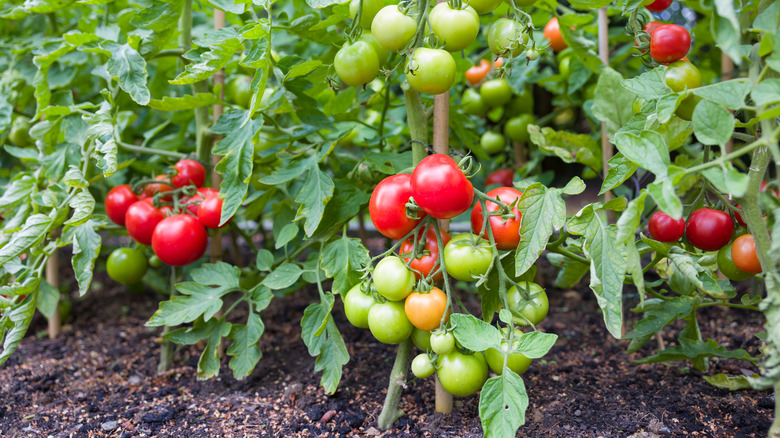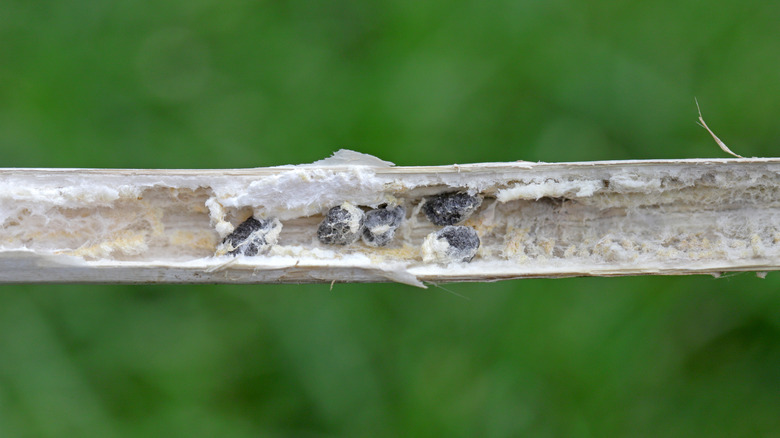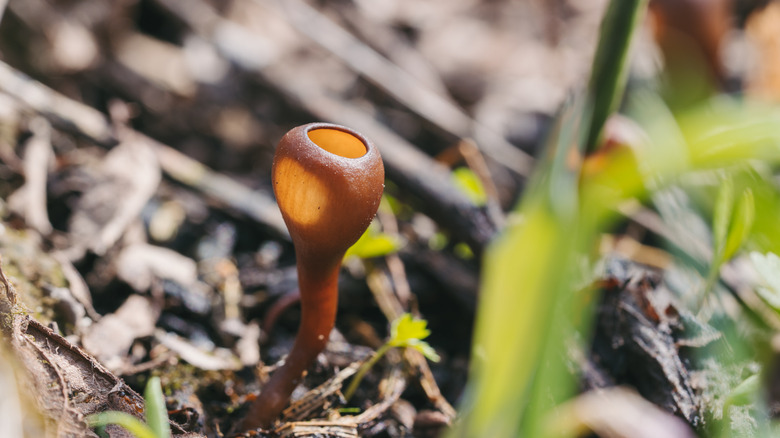What The White Mold On Your Tomato Plants Really Is And How To Prevent It
Without tomatoes, bruschetta would be dry toast, salsa would be a pile of onions and peppers, and tomato soup would be ...well ... hot water. Let's face it, in some dishes, there really is no substitute for tomatoes. If you're planning to showcase your garden tomatoes in your summer recipes, you're not alone. It seems tomatoes are headliners in many home gardens. According to The National Gardening Association, tomatoes are the most popular homegrown crop in the United States. While they are one of the easiest foods to grow in your garden, tomatoes are also susceptible to numerous diseases, including white mold — a potentially devastating disease that could derail your upcoming culinary compositions.
White mold (also called timber rot or stem rot) is caused by the fungus Sclerotinia sclerotiorum. A fairly common infection in tomato crops and many other vegetables, white mold can be frustrating to control because once it infects the soil it has the potential to come back year after year. Infections are most likely to occur during periods of cool, moist weather, especially when these conditions coincide with the flowering period. Learning to identify the signs of a white mold infection is key to limiting its effects and reducing the likelihood of reinfections. By taking a few preventive measures, you can ensure that your tomatoes survive to star in your summertime dishes.
How to identify white mold in tomato plants
White mold infections are initiated by tiny, black, seed-like structures called sclerotia found in the upper layers of the soil. When the weather is cool and moist, these sclerotia germinate and produce small, brown, cup-shaped mushrooms that eject thousands of spores into the air. Carried by the wind, these spores may travel up to a mile before landing on the foliage of potential host plants. The spores enter these plants through wounds or other openings. In tomatoes, they often infect the stem joints near recently fallen flowers.
Sometimes, white mold infections look similar to root rot or wilt disease, which also cause your tomato plant leaves to turn brown. However, you can spot the telltale symptoms of white mold by examining the plant's stems. Brownish water-soaked lesions develop near the base of the stems during the early stages of infection. As the disease progresses, patches of white, cottony fungus appear at the infected locations. Tiny black sclerotia are often visible within this fungal growth. Sclerotia also form inside the stems, which begin to look bleached, dry, and brittle. If white mold infects the main stem, the whole plant will eventually collapse. Although typically limited to the stems, white mold can infect tomato fruit, causing it to turn gray and then rapidly disintegrate in watery rot. When infected plants die, the sclerotia fall into the soil where they can stay dormant for several years and initiate infections in subsequent seasons.
How to treat and prevent white mold in tomato plants
Unfortunately, once a tomato plant is infected with white mold, there is nothing you can do to stop the progression of the disease. Pull up infected plants immediately but be careful not to knock sclerotia into the soil. These plants should be discarded, not composted. Fortunately, the fungus has just one annual infection cycle. Once you pull up the infected plants, you don't need to worry about further outbreaks. However, infections occasionally spread if the cottony growth directly contacts another plant, so continue inspecting your remaining plants for signs of white mold.
Fungicides won't help infected plants, but they can be applied as a preventative measure in future seasons. Although most of these fungicides are only available for commercial use, a study in the Journal of AgriSearch suggests Mancozeb may limit white mold in some plants. Physical controls are the most effective way to curtail white mold outbreaks. For starters, you should space your tomatoes out far enough so air can move through the plants, allowing them to quickly dry after watering or rainfall. To further reduce moisture, use drip irrigation systems or soaker hoses instead of sprinklers. Growing tomatoes in raised beds can also reduce moisture since soil in these beds dries quickly. Most importantly, inspect your garden frequently for signs of white mold, especially during flowering. With a bit of vigilance and a little TLC, you can ensure this summer's BLTs contain more than just bacon and lettuce.



